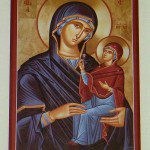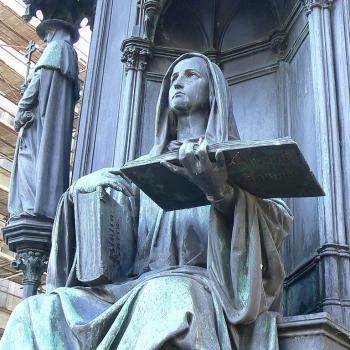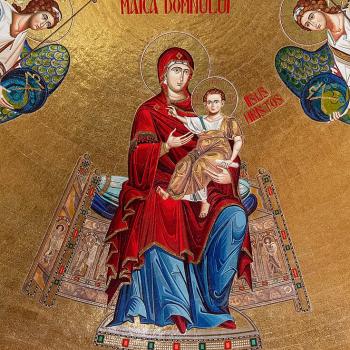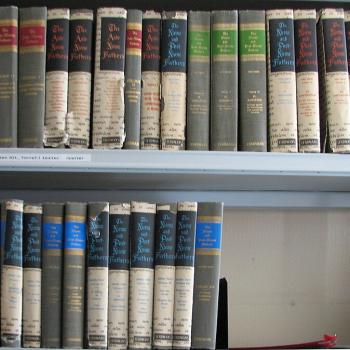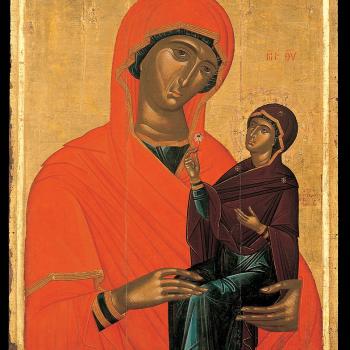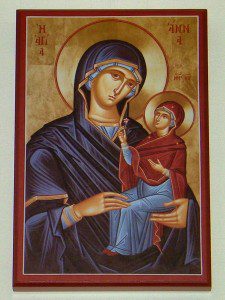
This is the fourth part of a series reflecting on Mary as Panagia, the All Holy One. Click here for Part I , click here for Part II, and click here for Part III.
Since the fall of Adam, God was at work with humanity, producing, as it were, a new tree of life, which we find established in and with the family tree of David. We could, and will to some degree, look beyond David and find other roots to this tree, such as Abraham, and see how God’s interaction with them was connected to the way God was preparing for the birth of the God-man in history.[1] Thus, we can read in relation to Abraham St. Hildegard describing how God descended into humanity through his seed:
At the Lord’s command, Abraham left his homeland and his kindred; through the wound of his flesh, which was the seal of faith, he went forth to fight against vices, as did the glorious standard bearer. For through the grace of the Holy Spirit, he was carrying the banner of holiness in front of the others, and through the outcome of his own works he obtained the privilege of highest holiness. Therefore in the oath under the thigh he prefigured the holy humanity of Christ; by the ancient plan of almighty God, namely, that God descends from his seed through his humanity, he destroyed the plan of the ancient serpent and freed humankind.[2]
God chose the line of David, which of course came out of the line of Abraham, to be the foundation upon which the accumulation of holiness needed for the advent of the God-man would be brought to fruition. God gave special graces to Israel, in and through the Law of Moses, to help water and nourish the seed of the new tree of life. That is, there was real and actual grace being given to Israel, and through Israel, to the family tree of the messiah, so that we can read not only how the law commanded sacrifices for sins, but how such sacrifices helped them receive forgiveness and become ritually pure (cf. Lev. chapters 4-6). Of course, we must recognize that there was a difference in the kinds of grace given before and after the incarnation.[3] Through Jesus we have more than the forgiveness of sins but deifying grace; we are given integral strength not only to preserve ourselves from sins, but to be transformed and to personally become greater than what we are by nature through grace, to become partakers of the divine nature (cf. 2Ptr. 1:4).
The Mosaic Law provided the proper environment for David’s line to develop and produce the messiah. The purity that was needed for the messiah’s birth was slowly grafted into the line of David through grace as his descendants followed the Mosaic Covenant, finding their weaknesses, their sins, forgiven through circumcision and priestly sacrifices.[4] In this fashion, God’s grace in the production of the messiah is not to be seen as a kind of deus ex machina, but as working with humanity, within human history, to produce Mary, a woman so full of grace that she would be free to say yes to God, not just for herself, but for the whole of humanity. Such grace made her free so that she could be employed by God for the hypostatic union of God the Word, demonstrating to the world, it is not human nature which is the problem, but the personal, fallen mode of engaging our humanity which leads to our spiritual destruction. Moreover, without the restoration of humanity in her, it would have been, and indeed has been for many, easy to claim Jesus’ humanity was not real. What was done by Jesus would be seen as a kind of divine fiat clothed in the appearance of humanity, with the general conclusion being that humanity itself, even in Jesus, could never be perfect.[5]
What we have said of the formation of Mary in history is also seen as representative of the way God worked with history to protect and preserve the integral goodness of human nature itself, to make sure it was not entirely destroyed by sin. In and through the goodness that remained within humanity after the fall, God could work with the remnant of that original humanity and let it grow, healing it from the effects of sin, until grace accomplished its end and the original, integral humanity was seen as reestablished in a woman, Mary. Indeed, as St. Symeon the New Theologian showed, we can see such work parallels the way flesh was originally taken from Adam and grew to become Eve:[6]
Because, just as she had done, so did Israel put aside faith and love for the god who had chosen him out of all the nations, abandon His worship, and offer liberations and sacrifices to idols, and ate and drank of them. God then, knowing this beforehand – since He is God and knows all things – took again from the same part set aside, I mean the side of Adam, and preserved it for Himself as His portion, His “lot,” from the tribe of Judah. And because all the rest were bound up together in faithlessness, He took His part set aside and built it up into a woman, I mean Mary the all-undefiled. Then, possessing in Himself, as a seed of the faith in God, the flesh assumed from the holy Theotokos and Ever-Virgin Mary, the most holy God built for himself a temple, became Himself the God-man.[7]
St Symeon described the preparation in history for the birth of Mary as the slow growth of a portion of Adam, of human nature, taken by God from before the fall so it could be preserved and brought back whole. That is, this flesh taken from unfallen humanity could be used to produce another perfect man, the second Adam, Jesus, even as Mary is to be seen as the re-establishment and perfection of Eve: “Now, since this flesh which He assumed from the pure Theotokos was not of the woman, but built up within a woman from Adam, Christ is said to bear Adam, and He becomes a second Adam taken from the first, and is called this by Scripture.”[8] Thus, the development of Mary is signified and explained as far back as Genesis in the production of Eve, and as Adam and Eve, in their creation, could be seen a pure and without sin, so we can see that God can and does make a perfect humanity, a sinless humanity, that to be human does not have to mean to be with sin.
More to Come Next Weekend
[1] The reason is that those who preceded David are automatically assumed to be in this line, and can be discussed as needed. Ultimately the “tree” traces itself all the way back to “Adam,” which, as we shall see, is how St. Symeon the New Theologian reflected upon the holiness found in Mary.
[2] Hildegard of Bingen, Solutions to Thirty-Eight Questions. trans. Beverly Mayne Kienzle, Jenny C. Bledsoe and Stephen H. Behnke (Athens, OH: Cistercian Publications, 2014),52.
[3] There is much debate had as to what kind of grace God gave to humanity before Christ, and the examination of the issue would go beyond our interests here. Nonetheless, a few things could be said. Such grace, we know, forgave sins and helped many follow God in righteousness and become recognized by God for their holiness (such as we see happened with Job). However, it is also clear, whatever grace which was given out before the incarnation had limits; the way to heaven was closed, even for the righteous patriarchs, so that in their death, they awaited the coming of the messiah to free them from the burdens of death. Only after Jesus could they find their way to their heavenly reward. Psalm 24, for example, is usually read as the victory hymn of Christ, where he, the king of glory, is seen to open the way to heaven for those who waited his coming. See for example, St. Augustine, On the Psalms in NPNF1(8):61. It is also clear all such grace ultimately is tied to the work and accomplishment of Jesus Christ, because, as we have seen, he was the lamb of God slain from the foundation of the world.
[4] As said above, there were many ways grace was given to humanity in the pre-Christian era. We can, therefore, talk about the “sacraments” of the Old Covenant, sacraments which participate in the work of Christ. Because they are said to prefigure or foreshadow the work of Christ, the grace they gave was real, but less than what is given in the sacraments of the Christian faith. Circumcision, faith and good works (which could and did include sacrifices of various kinds), provided the grace to overcome original sin and guilt, but not the grace needed for perseverance from sin and deification. See Peter Lombard, The Sentences. Book 4: On the Doctrine of Signs. trans. Giulio Silano (Toronto: Pontifical Institute of Medieval Studies, 2010), 6-9.
[5] Similarly, many have suggested that any perfect human could have accomplished the work of salvation so that if we find one perfect human (Mary) there would be no need for the incarnation. The problem with this argument is two-fold: one is it ignores how that perfection was achieved (because such perfection is tied to the graces given out by the God-man), but secondly, it fails to understand the reason why salvation had to be accomplished by the God-man, and not just a man. For the one who saves us deserves our adoration, to be loved by us in and through our whole being; but when we give such love to anyone other than God, we would be sinning against God by not rendering him the adoration which is only due to him. We would find ourselves damned by loving the one who saved us, which, of course, would be a contradiction and therefore an impossibility. Thus, for our salvation to be properly established, it needed it to be done by the God-man, and not just by any perfect human, so that our loving response can be proper without leading to new sins that would damn us once again.
[6] We do not have to take the Genesis account literally to understand the meaning behind the myth, and therefore, how that myth can be reflected in history in the slow social evolution which allowed for the birth of the new or real Eve, Mary.
[7] St Symeon the New Theologian, On the Mystical Life: The Ethical Discourses. Volume 1: The Church and the Last Things. Trans. Alexander Golitzin (Crestwood, NY: St Vladimir’s Seminary Press, 1995), 92.
[8] ibid., 92.
Stay in touch! Like A Little Bit of Nothing on Facebook:
A Little Bit of Nothing


